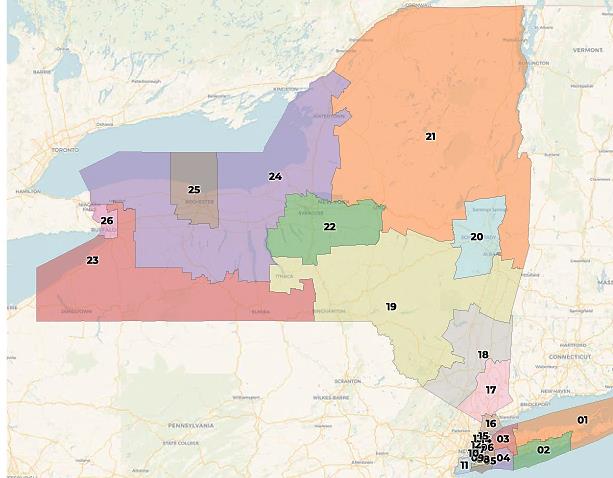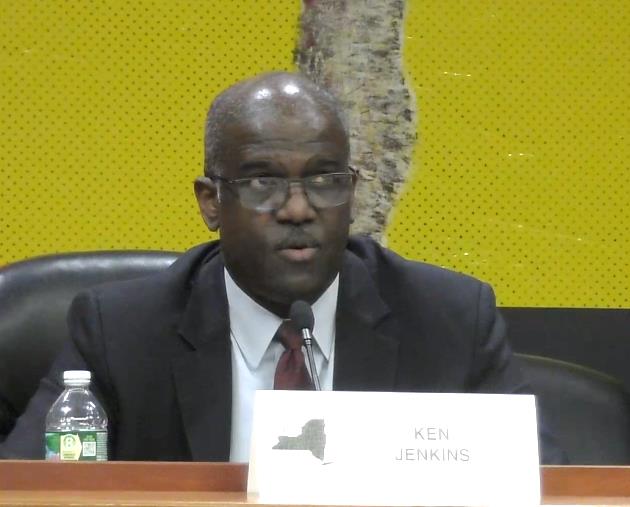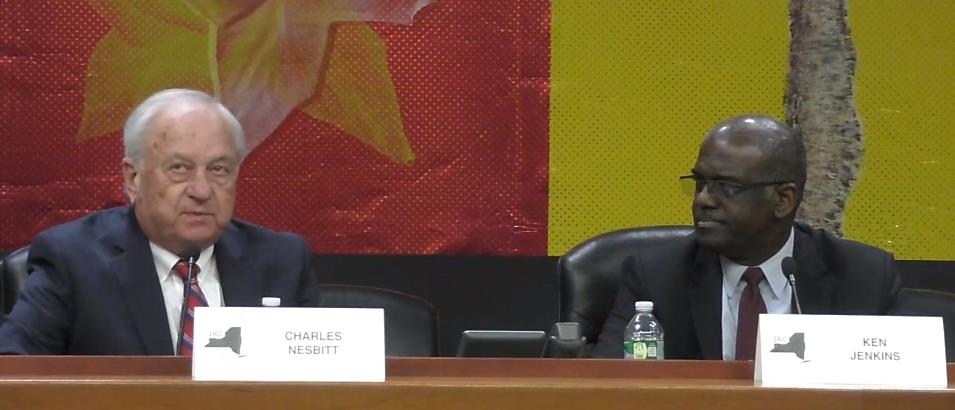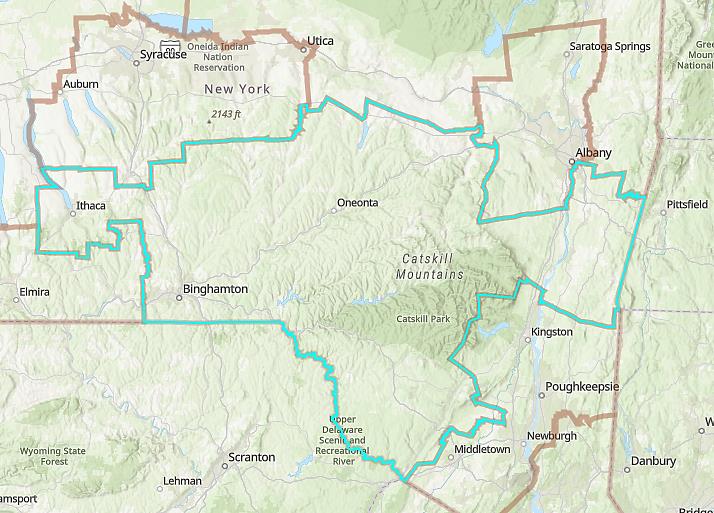
by Robert Lynch, February 15, 2024
Tompkins County Democrats, who’d hoped their super-blue bastion would finally wrest itself from Republican dominance and become the southern anchor of a more progressive-friendly Congressional district, found disappointment Thursday when the bipartisan New York State Independent Redistricting Commission (IRC) released, adopted, and sent to the New York Legislature its revised district lines to cover this November’s election and likely those for the rest of this decade.

The Commission, by a vote of nine-to-one, its members evenly-divided between the two parties, voted to keep all of Tompkins County within the sprawling, eastern southern tier 19th Congressional District, the district narrowly won two years ago by Republican Congressman Marc Molinaro. The Commission changed NY-19 only at the edges—literally—but the revisions it’s made by some accounts could make it harder for the presumptive Democratic nominee, Josh Riley, to beat Molinaro this November.
Neither Riley nor Molinaro had commented on their websites about the Commission’s recommendations, as of Thursday evening.
“The process was not without its challenges, but I am proud to say that we have worked cooperatively and collaboratively to address those challenges, and so will be voting on a single consensus plan today,” Ken Jenkins, a Democrat and Chairman of the IRC said. “This vote is ultimately a victory for the commission process and for democratic—small “d”—democratic participation in the State of New York.”
“We came into existence to solve these kinds of problems, Charles Nesbitt, Republican co-Chair of the Commission, said. And their solution, Nesbitt added, can only happen “through cooperation and compromise.”
“The process has met both of these challenges, “Nesbitt said. “And we are here today with a map that we have agreed to and sent to the Legislature.”

But what the New York State Senate and Assembly do with that map handed them Thursday remains an open question. Democrats hold supermajorities in both legislative chambers. Two years ago, when a somewhat different Commission scenario played out—taking the form of a partisan deadlock on the Commission with two, partisan-competing maps handed up—legislators played the gerrymander game. They drew their own maps bound to favor Democratic victories in otherwise swing districts and “packed” Republicans into ruby-red enclaves like Elyse Stefanik’s in the North Country and the western southern tier district long held by former Congressman Tom Reed.
But the Court of Appeals struck down the Democrats’ gerrymandering. A court-appointed special master drew the more politically-competitive maps that we now have. And because of that judicially-directed artwork, voters in 2022 elected Marc Molinaro in NY-19 and Republican Brandon Williams to our north in the Syracuse-centered 22nd District.
When a more liberally-tilted Court of Appeals last December concluded that the special master’s maps were good for only one election cycle, the Court charged the Commission to return to work. It did. But this time, Commissioners did not deadlock. So the New York Legislature faces different circumstances now than it did two years ago. What’s more, lawmakers stand in recess, not scheduled to return to work until about February 26th. That would be one day before candidates begin circulating party designating petitions.
“The redistricting process in New York is already two years behind schedule and we’re up against deadlines,” Jeffrey Wice, senior fellow at New York Law School’s New York Census and Redistricting Institute, told the downstate-based website City & State. “I don’t think anybody has the will to really fight this thing out and then get back in court over again and prolong the process any further.”

Two years ago, Senate Deputy Leader Michael Gianaris proved to be gerrymandering’s wildest cheerleader in the upper house. Before the Commission’s vote, Gianaris sounded less ready this time for a fight, with no pre-prepared plan in the works. “I trust that our team can turn around a map quickly if necessary, but don’t know if it will be,” was all that Gianaris would tell City & State’s Rebecca Lewis.
Yet at least one Albany Democrat is bracing for battle. He’s State Senator James Skoufis, the lawmaker who most recently enraged upstate Republicans by leading the drive to move local elections to even-numbered years. Skoufis did not mince words. “These maps are a disgrace and ought to be rejected by the Legislature,” the Hudson Valley Democrat said.
While Tompkins County would remain within Molinaro’s 19th Congressional District should the Redistricting Commission’s maps be adopted, some of our county’s immediate neighbors would find themselves transplanted into different districts. Cortland County, now wholly within NY-19, would be sliced east-to-west. Southern towns would stay within the Molinaro District; those to the north, including the City of Cortland, would join Brandon Williams’ 22nd District. Southern Cayuga County, including Auburn, would be plucked out of Republican Claudia Tenney’s 24th District and merged into Williams’ as well.

Tioga County, currently totally within the 19th District, would move in total to the western southern tier 23rd District, where Republican Nick Langworthy represents many of Tom Reed’s former constituents. Schuyler County, like Cortland, would be chopped across the middle. The Town of Hector and other northern towns in that county would slide from Langworthy’s district to Tenney’s.
Many of the adjustments to the 19th District happen to the east. Tompkins County would still remain the 19th’s westernmost anchor, and Binghamton and Broome County would remain within its bounds. But the 19th would expand to include all of Otsego County, plus Schoharie County, and portions of Orange County in the Catskill region. The IRC’s plans would continue to stretch the district east to the Massachusetts state line.
The adjustments to our district’s eastern fringe could be the product of that “cooperation” and “compromise” that Commissioners Jenkins and Nesbitt talked about. Republicans may achieve gains for Molinaro. Yet Democrats may secure benefits for their party’s freshman Congressman in a district to the southeast of ours, Representative Pat Ryan.

But the big prize for Democrats may be that Syracuse-based 22nd District, that Republican Brandon Williams won two years ago by the narrowest of margins and which Democrats would dearly love to flip this time. Democrats won’t have Ithaca to add to the 22nd to make it more progressive-friendly. But the IRC’s plan would give them Cortland and Auburn.
The Cook Political Report has rated Williams’ 22nd District a toss-up, and Commission tinkering has probably tipped the scales toward Democrats a bit further.
Grant Reeher, director of the Campbell Public Affairs Institute at Syracuse University, told WRVO Radio that the 22nd Congressional District has gotten more Democratic friendly. But he notes that the district was already Democratic friendly and doesn’t view the new congressional lines as a game changer.
Meanwhile, Brandon Williams is taking things in stride. “I find myself in my 5th congressional race in just two-years,” the generally Trump-loyal Republican said in a statement. “Changing lines won’t change minds—voters want common sense and relief from Progressive fantasies.”
[Expect more to be posted as this story develops.]
###

